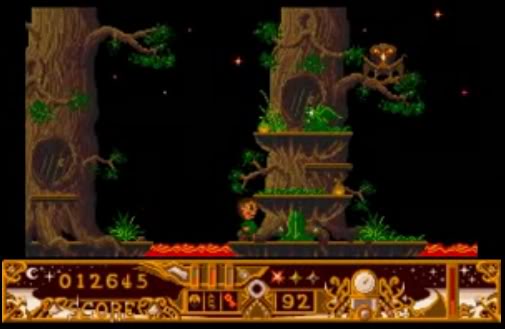You notice a lot of things when you walk in the aftermath of a storm. The most particular thing that caught my attention was the clouds. Not their shape, or their size, nor their names that we should all remember from high school geography, yet don't.
It was the speed they were travelling at. Or more particularly, the apparent difference in speed between various clouds. I say apparent, because in reality, the clouds could have been moving at the same speed. Yet due to differences in distance, the eye perceives the closer clouds to be moving faster, and the further clouds to be moving more slowly.
The clouds appeared to be structured as a three-dimensional layer. Immediately I was reminded of the 1980's and early 1990's era of parallax scrolling, or as I like to call it, the original cloud computing.
I will not get into a technical description of parallax scrolling, simply because there is not one method of achieving its effect; differences between computer system architecture in the 1980's meant that even the same game being ported to two different systems may have required a change in coding simply to apply the parallax scrolling.
However, the general idea is that two-dimensional game can look three-dimensional simply by having the background move at a different speed than the foreground. Take Super Mario Brothers for example. The original game (8-bit, NES) did not have parallax scrolling. If you watch the game in action, notice how the clouds in the background simply move back or forward at the same speed as the foreground. There is no perception of depth, and so simply a two-dimensional experience.
[embed:http://www.youtube.com/watch?v=ia8bhFoqkVE ]
Now take a look at Super Mario World, released on the SNES (16-bit). Even in the opening sequence, you can immediately see the difference. Although still a two-dimensional game, the background features such as the clouds are moving at a slower speed than the foreground objects. This parallax scrolling now gives the world of Mario a three-dimensional twist.
[embed:http://www.youtube.com/watch?v=htFJTiVH5Ao ]
This effect has been used in a countless number of games (as well as in television animations since the 1940's). From the humble beginnings in a game called Moon Patrol (1982), to famous 16-bit era games such as the Sonic series. In fact, even today, this technique is being used, albeit more often on websites rather than in games. Take a look at this New Zealand tourism website, using parallax scrolling to achieve a 3D illusion http://www.newzealand.com/us/.
From my example of the clouds, it is obvious that parallax scrolling exists in nature, and as clouds are one of the more common background images used in games in a parallax capacity, I think it is safe to assume that the natural 3D formations of cloud layers have been an influence on the development of three-dimensional game programming techniques.
“Dark Forest”, the most memorable (and terrifying) level in Twinworld from my childhood
There are many examples throughout gaming history that highlight the importance of nature; how it can be used as a technique to create atmospheric environments for the gamer to manipulate. I remember distinctly a game I used to play when I was a child. It was released on a variety of platforms, the definitive version perhaps being on the Acorn Archimedes.
In Twinworld, you play the role of a young man travelling on an adventure through a variety of lands, growing older, and fighting monsters on the way. All in all, a standard adventure game (if you read my previous article on interactive fiction, you will know where adventure games originated!), with a few interesting perks. One of these was the atmosphere.
Unlike many other platformer games of this era, such as the Mario series, Twinworld was set in a fantasy but realistic world. There were no random floating boxes, no pipes to jump down, no unexplainable moving platforms. Instead, there were caves, trees, wild birds from the trees who would attack you. It was the nature in this game that makes it memorable for me. Any time I enter a forest today, I am reminded of the years I spent exploring the "dark forest" in Twinworld.
The huge achievements in graphical technology in the last few years has resulted in a lot of visually spectacular games. One prime example would be the latest in the Elder Scrolls series, Skyrim. As with the previous games in this series, there are two styles of gameplay. One is to complete the main quest, and as many side-quests as possible, and the second is to explore the world, and effectively live in it as a fantasy character.
In Morrowind for example, I spent a great deal of time collecting various plants from around the land, with the objective of bringing them to my home laboratory and using any alchemy "recipes" I could find in various books I came across, create a variety of potions. A fun concept, extremely well designed, and at the roots of it, completely derived from our natural environment.
Skyrim in particular has a following of gamers who simply want to produce the greatest graphics possible with their computer systems, and explore this fake, but convincingly natural world. For example, here is a video entitled "Skyrim Beauty", simply produced to demonstrate the countryside of this imaginary land.
[embed:http://www.youtube.com/watch?v=wDQKixxKCZk&feature=related ]
There are many other aspects of nature that have found their place in computer game culture, far too many to go into here. From the concept of sunrise and sunset dictating times and schedules (more advanced text adventure games featured time, the Elder Scrolls series features prominent sunsets resulting in the populations going to sleep), to audio effects being directly recorded from the outdoors to provide a convincing atmosphere in what would otherwise be an unconvincing world.
Without our experiences of the outdoors, and our observations of the natural world around us, technology today, especially in the world of computer games, would be vastly different. While the term "cloud computing" is now used to describe the idea of hosting data remotely, let us remember the real clouds, for it is they who have helped create the virtual worlds we love.


